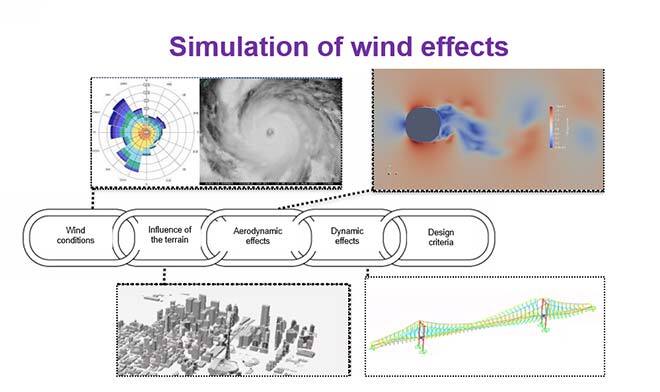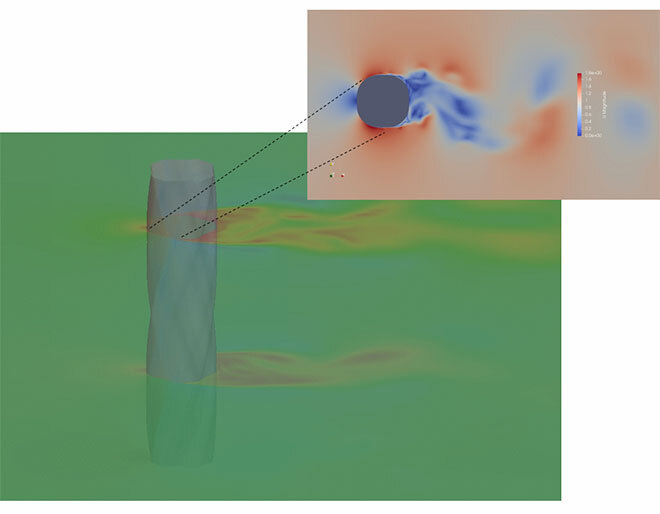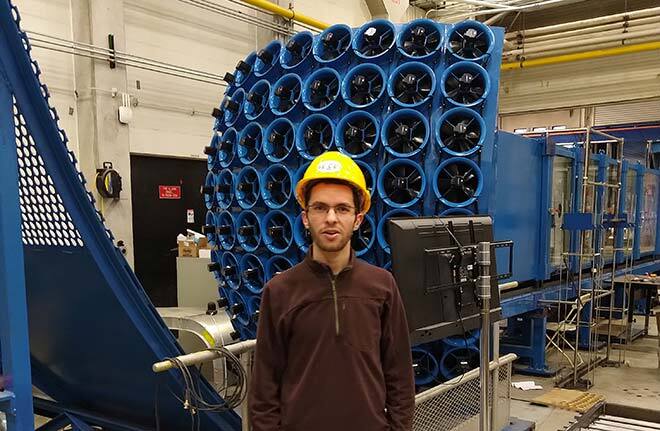Dynamic Structures Adaptable to Wind

Purchased on Istockphoto.com. Copyright.
Wind engineering is a discipline focused on the simulation and characterization of interactions between wind and structures in the built environment. Its most prominent example is the Tacoma Bridge, which collapsed in 1940, in an era when little was known about such interactions.
Since then, the need for wind engineering expertise has increased significantly. Buildings, bridges, wind turbines, transmission tower-line systems and other structures, built to meet specific codes and standards, must withstand extreme weather events, the frequency and magnitude of which are increasing with climate change. In addition, urban densification as seen on a global scale leads to the construction of increasingly taller buildings with high exposure to weather and wind. At ÉTS, we are developing mitigation methods allowing structures to adapt to their environment.
Complex Aerodynamic Interactions
First and foremost, we must be able to characterize the type of wind and its force—is it a hurricane, downburst, winter storm or merely a synoptic wind? Some hazards are accompanied by other phenomena, such as rain, snow or ice, which will also have an impact on structure behaviour. And before reaching the structure, the wind will encounter obstacles that will modify it, depending on the topography.
The main challenge with wind is that the force it exerts is intricately linked to the aerodynamic shape of the structures it hits. Indeed, the dynamic response of the structure will affect the aerodynamic force of the wind and vice versa. Given this complexity, how can the aerodynamic and dynamic analysis of a given structure be performed? By using models based on physics principles, experimental studies and artificial intelligence.

Figure 1: Steps leading to the design of wind-resistant structures
Wind Field Characterization
Large-scale models applied in atmospheric science are highly accurate but need too much computational power to allow real-time responses or to perform probabilistic studies, which require many simulations. Therefore, we use other tools combining physics-based equations and artificial intelligence models with the advantage of requiring fewer data for training, while being more efficient and much more accurate. To evaluate the effect of terrain on the wind field, experimental methods (i.e. wind tunnel model tests) will usually serve to generate data needed to train artificial intelligence models, and obtain rapid predictions.

Figure 2: Wind characterization
Structural Dynamics Analysis
Forces exerted by the wind according to the aerodynamic shape of a structure are obtained from models derived from wind tunnel studies, computational fluid dynamic models and reduced order models (e.g., deep learning) trained with experimental data. Only once these forces are known, can the dynamic analysis of the structure be performed and thus the calculation of accelerations and displacements to which it will be subjected. This allows us to propose modifications to optimize the structure.
A More Resilient Built Environment
We are exploring several solutions to create dynamic buildings with mechanical and aerodynamic properties to make them adaptable to a changing environment. For example, a building could change its aerodynamics with plates installed at each corner, where angles could be controlled to change the wind field. The goal is to minimize aerodynamic forces, reducing the building’s response to displacement and acceleration. Innovative materials capable of changing shape will also be studied to achieve the same objective.
Fluid injection becomes an interesting option when these techniques cannot be considered, for example due to architectural constraints. This technique consists in injecting air at certain locations of the building through a network of ducts inserted in the envelope. Optimization calculations based on deep reinforcement learning models determine in real time the injection locations and air flow rates to change the wind field, thereby minimizing aerodynamic forces.

Figure 3: Injecting fluids to change the wind field
From Smart Cities to Drone Landings
Large-scale simulations can also be performed to identify at-risk neighbourhoods, order evacuations or implement mitigation measures. Here, artificial intelligence models are trained from data generated by high-fidelity models. To ensure accuracy, some sensors are installed at strategic locations—the data transmitted in real time improve prediction accuracy (data assimilation technique). This type of simulation can also help drones carrying rescue equipment reach target areas safely, avoiding areas affected by strong winds.
Ever Increasing Needs
Climate change coupled with population densification will lead to an increased need for expertise to ensure that our built environment structures remain safe throughout their useful life. Much research is needed to address the many challenges posed by the wind. At ÉTS, we intend to contribute by developing effective and realistic solutions.

Figure 4: The author in front of a wind tunnel



